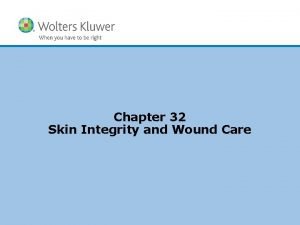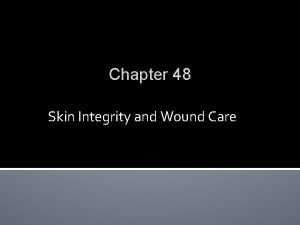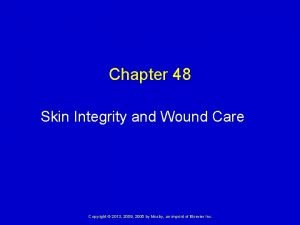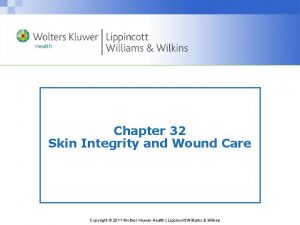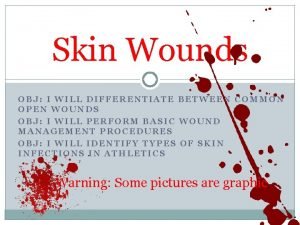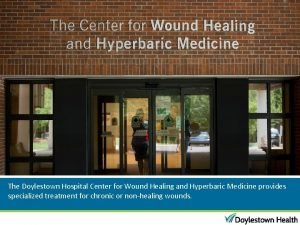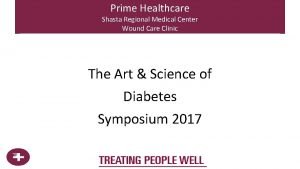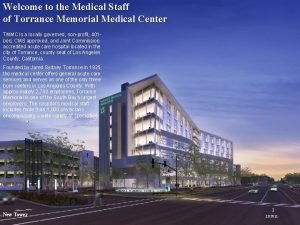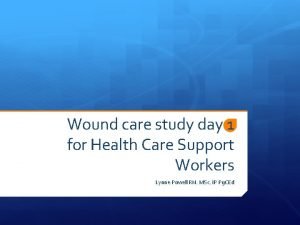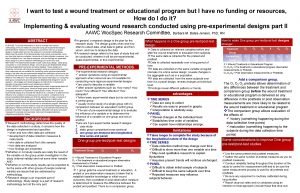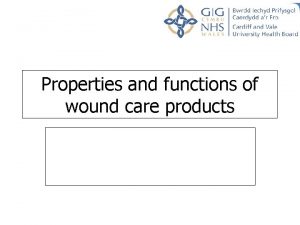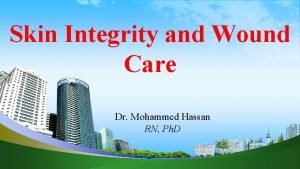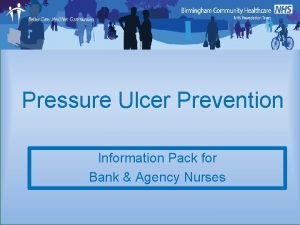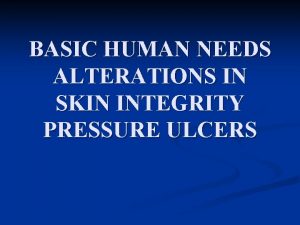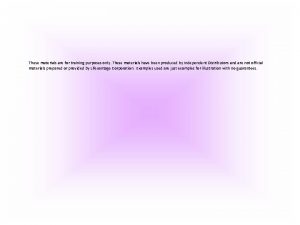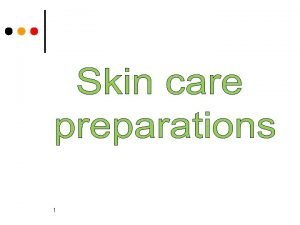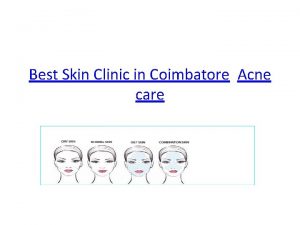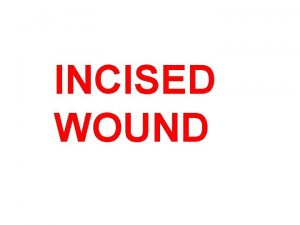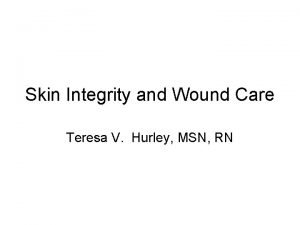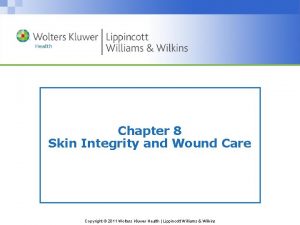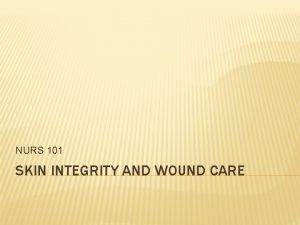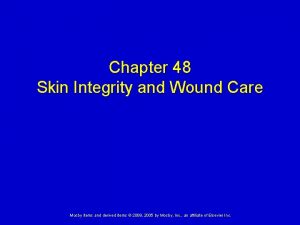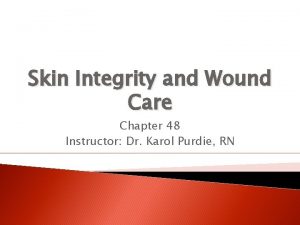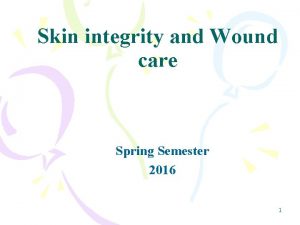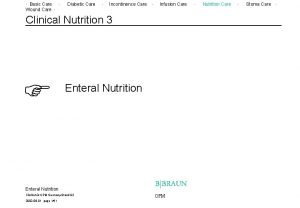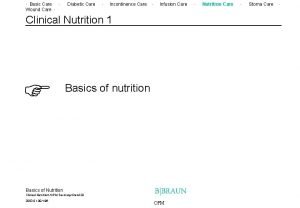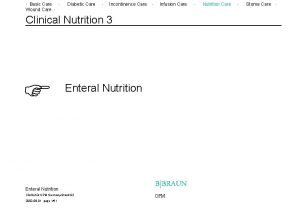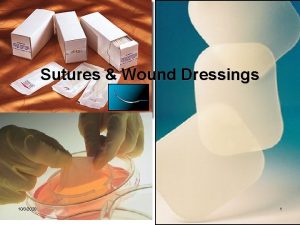SKIN INTEGRITY AND WOUND CARE SKIN AND SKIN
























- Slides: 24

SKIN INTEGRITY AND WOUND CARE SKIN AND SKIN BREAKDOWN

WOUND CLASSIFICATION: AN INTENTIONAL WOUND UNINTENTIONAL WOUNDS AN OPEN WOUND AN CLOSED WOUND

PHASES OF WOUND HEALING INFLAMATORY PHASE FIBROPLASIA (Proliferation )phase Maturation (remolding) phase

WOUND HEALING PROCESSES PRIMARY HEALING SECONDARY HEALING TERTIARY HEALING

FACTORS AFFECTING WOUND HEALING AGE CIRCULATION & OXYGENATION WOUND CONDITION OVERALL PATIENT HEALTH

WOUND COMPLICATIONS INFECTION: Ø Purulent Drainage Ø Increased Drainage Ø Pain Ø Redness Ø Swelling Ø Increased Body Temperature Ø Increased White Blood Cell Count (WBC)

DEHISCENCE OR EVISCERATION DEFINE EACH: Patients at greatest risk for these complications Include: Ø Obese or malnourished Ø Have infected wounds Ø Excessive coughing Ø Vomiting or straining

HEMMORHAGE Occurrences may be due to: Slipped sutures A dislodged clot from stress at the suture line or operative site Infection Erosion of a blood vessel by a foreign body such as a drain

PSYCHOLOGICAL EFFECTS OF WOUNDS PAIN ANXIETY AND FEAR ALTERATION IN BODY IMAGE

ASSESSING THE WOUND Inspection Sight Smell Palpation Appearance Drainage Pain

DIAGNOSING IN WOUND CARE Altered skin integrity Risk for infection Pain Delayed surgical recovery Body image disturbance

PLANNING EXPECTED OUTCOMES FOR WOUND CARE Facilitating the patients return to health Providing interventions that facilitate wound healing Reduce the risk for complications Promote psychosocial adaptation

IMPLEMENTING WOUND CARE Promote wound healing Prevent further injury Prevent alterations in skin integrity Prevent infections Promote physical and emotional comfort Facilitate coping

TEACHING FOR HOME CARE OF A WOUND Explain the terminology Identify risk factors Explain where and how pressure ulcers develop Describe various prevention strategies and options

EVALUATING WOUND CARE Evaluating is based on the expected outcome (EO) No complications Wound is progressing through the healing stages

PRESSURE ULCERS: PATHOLOGY OF ULCER DEVELOPMENT: External Pressure Friction Shearing Forces

FACTORS AFFECTING PRESSURE ULCER DEVELOPING Mobility Immobility Nutrition Hydration Moisture on the skin Mental status Age

PRESSURE ULCER STAGING Stage III Stage IV

ASSESSING THE RISK FOR: PRESSURE ULCERS Nursing history Physical assessment pg. 933 Mobility Nutrition Incontinence Use of Braden scale pg. 936

ASSESSING: “ACTUAL” PRESSURE ULCER 1 st sign of pressure =“blanching” (local anemia, is called “ischemia”) Ischemia is rapid followed by hyperemia when pressure is relieved.

DIAGNOSING PRESSURE ULCERS Impaired Skin Integrity* The stage of the ulcer is a factor in determining the nursing diagnosis Stage I and II pressure = superficial skin damage. Stage III and IV pressure ulcer = full thickness skin loss and damage to underlying tissue Impaired Tissue Integrity is more appropriate*

PLANNING EXPECTED OUTCOMES FOR PRESSURE ULCERS Patient participation Demonstrate progression in healing of the ulcer Demonstrate increase in body wt. and muscle size Remain free of infection at the wound site Develop no new areas of skin breakdown Demonstrate self-care measures necessary to prevent development of a pressure ulcer

IMPLEMENTING INTERVENTIONS TO PREVENT PRESSURE ULCERS: Protecting the skin from external mechanical forces Teach patient and caregivers about prevention Pressure ulcer care Cleaning the pressure ulcer Dressing the pressure ulcer Controlling infection Providing care when surgical intervention is necessary

Evaluate Pressure Ulcer Care Had the patient and caregiver participated effectively in prevention and treatment Prevention of additional skin breakdown Demonstrated progressive healing of pressure ulcer Remained free of infection Improved overall physical condition
 Chapter 32 skin integrity and wound care
Chapter 32 skin integrity and wound care Chapter 48 skin integrity and wound care
Chapter 48 skin integrity and wound care Copyright
Copyright Wolters kluwer
Wolters kluwer Skin wound
Skin wound Ryb color code wound care
Ryb color code wound care Doylestown wound care center
Doylestown wound care center Shasta regional wound care
Shasta regional wound care Aileen takahashi md torrance ca
Aileen takahashi md torrance ca Transient contact
Transient contact Wound care pretest
Wound care pretest Wound care near freedom
Wound care near freedom Aqucel
Aqucel Types of care primary secondary tertiary
Types of care primary secondary tertiary Skin integrity assessment
Skin integrity assessment Skin integrity assessment
Skin integrity assessment Anatomical location
Anatomical location Altered skin integrity
Altered skin integrity Stratum granulosum
Stratum granulosum Thin skin vs thick skin
Thin skin vs thick skin Basic facial steps milady
Basic facial steps milady Training purposes only
Training purposes only Basic skin care definition
Basic skin care definition Best skin care clinic in coimbatore
Best skin care clinic in coimbatore Royal skin care
Royal skin care
